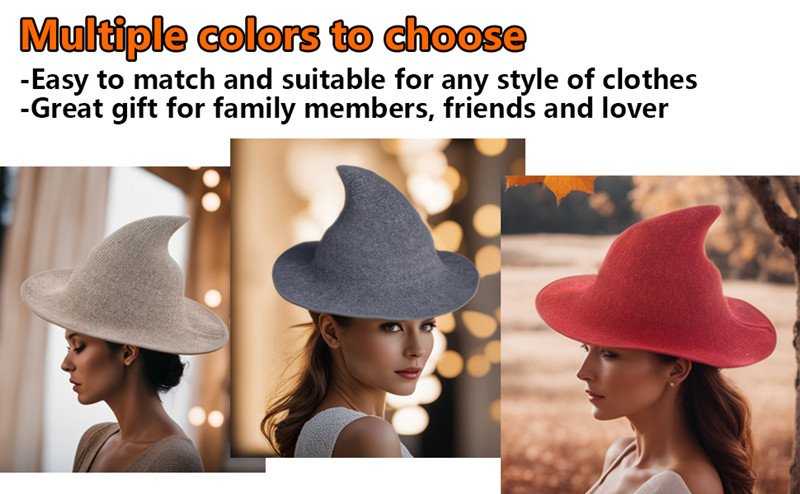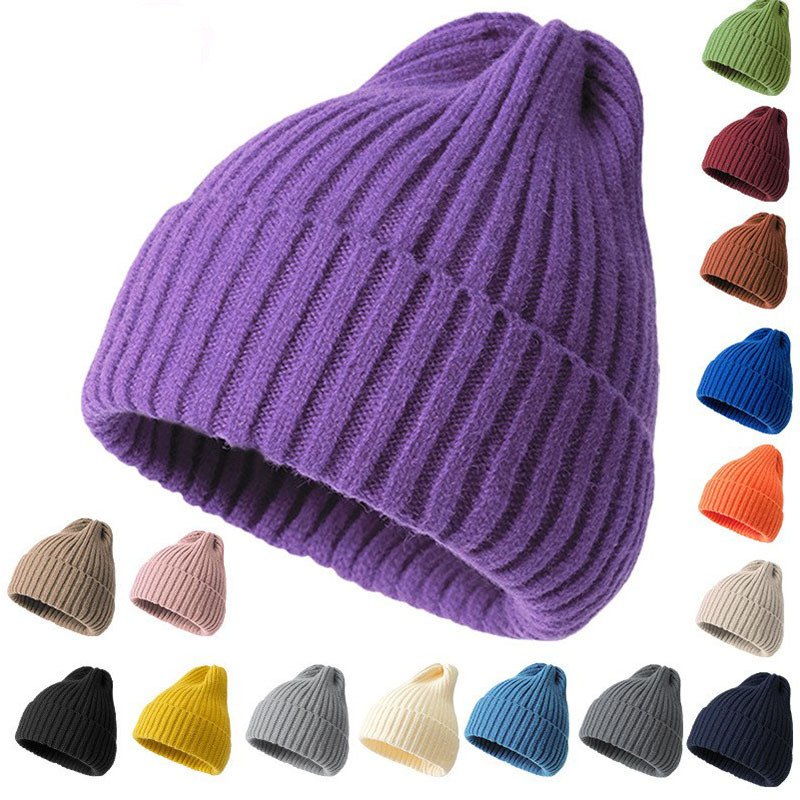Hats have been an essential part of human fashion and function for centuries, serving as both protection and expression. Among the countless styles, two hats stand out for their symbolic and practical value: the Halloween witch hat and the knit hat. At first glance, they may both cover the head—but beyond that, these two headpieces couldn’t be more different.
In this blog post, we’ll explore the origins, design, cultural symbolism, uses, materials, and fashion relevance of both the Halloween witch hat vs. knit hat. Whether you’re a fashion enthusiast, a Halloween fanatic, or just curious, this guide will help you understand not only how these hats differ, but what they say about the people who wear them.
1. Origins and History
Halloween Witch Hat
The witch hat is instantly recognizable: tall, conical, and often adorned with a wide brim. Though today it’s most often associated with costumes and Halloween festivities, its roots are tangled in folklore, fear, and superstition.
The pointed witch hat likely evolved from several sources. In medieval Europe, pointed hats were worn by certain groups, including heretics, Jews, and outsiders, as a means of ostracism. Over time, witches—already vilified and feared—were depicted in popular culture with these pointed hats to mark them as dangerous and different.
During the 17th century witch hunts in Europe and colonial America, the image of the “witch” became more standardized, thanks to literature and illustration. By the 19th and 20th centuries, especially with the rise of Halloween traditions, the witch hat had morphed into a cartoonish accessory, no longer feared but playfully embraced.

Knit Hat
The knit hat, on the other hand, is a product of practicality. Often called a beanie, toque, or watch cap, the knit hat has been around for centuries as a way to keep warm in cold climates.
Its origins trace back to early civilizations, including the ancient Greeks and Romans, who used woolen caps for insulation. In the Middle Ages, knit caps became popular among European laborers and fishermen for their warmth and snug fit. By the 20th century, they became widespread in both military and civilian attire.
Today, knit hats are ubiquitous. Found in every wardrobe regardless of age or gender, they are both functional and fashionable.

2. Design and Structure
Witch Hat Design
A Halloween witch hat typically features:
- Tall cone shape: The pointy top is its defining feature.
- Wide brim: Helps balance the tall crown and creates a dramatic silhouette.
- Rigid material: Often made from felt, polyester, or stiffened fabric to maintain shape.
- Decorative elements: Buckles, mesh veils, glitter, or feathers may be added for flair.
Witch hats are designed more for visual impact than comfort or function. They are theatrical and exaggerated, meant to invoke mystery, power, or whimsy depending on the costume.
Knit Hat Design
A knit hat is more understated:
- Rounded crown: Fits the natural shape of the head.
- Stretchy fabric: Usually made from wool, acrylic, or blends that stretch to fit.
- Optional pom-pom: A soft ball on top, originally a military design feature.
- Variety of knits: Ribbed, cable-knit, double-layered, or fleece-lined.
These hats are built for warmth, comfort, and everyday wear. Some have ear flaps or are designed to be worn slouched or folded at the rim, adding to their versatility.
3. Functionality and Use
Witch Hat Function
The witch hat serves almost exclusively as a costume accessory. Its functions include:
- Character portrayal: For Halloween, theater, cosplay, or events like Renaissance fairs.
- Thematic decoration: Used in parties or displays.
- Symbolic use: In literature, movies, or cartoons as an icon of magic.
Witch hats aren’t worn in daily life. They are impractical for most weather and aren’t designed for long-term comfort. Their role is to create atmosphere, not to serve utility.
Knit Hat Function
Knit hats, however, are one of the most functional types of headwear in existence. Uses include:
- Insulation: Protects the head from cold temperatures.
- Athletic wear: Used by skiers, snowboarders, and runners.
- Workwear: Essential gear for outdoor laborers in cold regions.
- Fashion: Worn as a style statement or accessory.
- Bad hair days: A go-to solution when styling isn’t an option.
Thanks to their light weight, affordability, and comfort, knit hats are suitable for everyday use.
4. Cultural Symbolism
Witch Hat Symbolism
The witch hat is steeped in cultural and symbolic meaning:
- Magic and mysticism: Represents supernatural power, spellcraft, and otherworldly knowledge.
- Rebellion and empowerment: In modern feminism, witches are often embraced as symbols of female power and resistance against patriarchy.
- Fear and fantasy: Traditionally associated with evil or malevolent forces, especially in medieval and Puritan times.
- Transformation: A costume piece that instantly changes one’s identity, turning anyone into a “witch.”
From The Wizard of Oz to Harry Potter, the hat has evolved from a symbol of dread to a symbol of fun and magic.
Knit Hat Symbolism
The knit hat is more subtle but equally rich:
- Working-class identity: Long associated with fishermen, lumberjacks, and manual laborers.
- Subculture style: Adopted by skaters, punk rockers, and hipsters for different aesthetic reasons.
- Winter spirit: Evokes feelings of coziness, hot cocoa, and snow days.
- Anonymity and warmth: Often worn in cold cities as a way to stay warm while blending in.
Though less theatrical than the witch hat, the knit hat carries emotional and cultural weight in its o5. Material and Craftsmanship
Witch Hat Materials
Because Halloween witch hats are costume pieces, they’re often made from:
- Felt
- Polyester
- Foam or wire mesh
- Plastic (for novelty versions)
These materials are chosen for their ability to hold shape and their low cost. High-end versions (used in theater or film) may use better fabrics, linings, or custom construction.
Knit Hat Materials
Knit hats are made for real-world conditions, so materials are chosen for insulation and breathability:
- Wool: Natural warmth, moisture-wicking, and durability.
- Acrylic: Cheaper than wool, hypoallergenic, and easy to wash.
- Cashmere or alpaca: Luxury options, soft and warm.
- Fleece-lined: Added warmth for extreme cold.
Craftsmanship matters with knit hats. Hand-knit versions are often prized for their uniqueness and quality.
6. Fashion and Seasonal Trends
Witch Hats in Fashion
While not a fashion staple, the witch hat does appear in niche or seasonal trends:
- Halloween collections: Every October, fashion brands release themed items, including witch hats.
- Gothic or witchcore aesthetics: Some alternative fashion styles incorporate dramatic hats year-round.
- Runway influence: Occasionally appears in avant-garde fashion or haute couture shows.
These appearances are more about expression and attitude than practicality.
Knit Hats in Fashion
Knit hats are a fashion mainstay during fall and winter:
- Designer labels: Brands like Gucci, Moncler, and The North Face offer luxury versions.
- Street style: Paired with puffer jackets, jeans, and boots for urban chic looks.
- Color and pattern trends: Each season brings new palettes, from neutral earth tones to bold brights.
They’re also a canvas for personal style—some people cuff theirs tightly, others let them slouch or pull them low over the ears.
7. Psychological and Emotional Impact
What a person wears affects how they feel. Hats, in particular, can significantly alter one’s identity, even temporarily.
Witch Hat Impact
Putting on a witch hat is a transformation. It invites:
- Imagination and fantasy
- Confidence and playfulness
- Connection to folklore and history
People who wear witch hats, even temporarily, often feel a sense of power, magic, and otherworldliness.
Knit Hat Impact
Wearing a knit hat offers:
- Comfort and warmth
- Security and coziness
- A sense of casual, relaxed identity
Many people wear knit hats as part of their “home” or “comfort” identity, associating them with cold weather rituals and peaceful vibes.
Conclusion: Witch hat vs. Knit hat – Two Hats, Worlds Apart
At their core, both the Halloween witch hat and the knit hat cover your head—but the why, how, and when are entirely different. One is bold, magical, symbolic, and theatrical. The other is practical, understated, and universal.
In summary:
| Feature | Witch Hat | Knit Hat |
|---|---|---|
| Primary Use | Costume/Decoration | Warmth/Fashion |
| Material | Felt, foam, polyester | Wool, acrylic, fleece |
| Symbolism | Magic, fantasy, witchcraft | Warmth, simplicity, everyday life |
| Comfort | Low (typically) | High |
| Functionality | Low | High |
| Cultural Role | Seasonal, theatrical | Year-round, practical |
So next time you reach for a hat—whether to cast a spell or keep out the cold—remember that you’re not just accessorizing. You’re participating in a long and fascinating history of style, culture, and identity.

